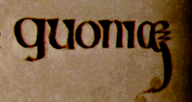

The flourish on x overlaps adjacent letters and is used for decoration, as in line 6:


 |
 |
Spacing and Proportions
The text looks compact and well spaced because


The flourish on x overlaps adjacent letters and is used for decoration, as in line 6:


 |
 |
Layout
 |
|
In line 4 he appears to have left a large gap between illi and s, which is actually part of the same word, in order to space the line properly.
 |
At the bottom of the page he has turned the m of quoniam on its side in order to justify his line. |
Return to Question Page
This is a Gospel Book, for display and use in church services. However, unlike the Vespasian Psalter it is not arranged per cola et commata. It is a narrative, though our sense that it is therefore arranged as prose must be tempered by the fact that the Gospel was often sung as part of the liturgy.
 |
Verse 41: Adhuc autem (line 4). |
 |
Verse 44: Et dixit (line 10). |
 |
Verse 45: Tunc aperuit (line15). |
 |
 |
 |
Other marks which look like stops are in fact the pricks made by the scribe before ruling his page.
 | |
Return to Question Page
Word division
 |
Et dixit ad eos / haec sunt uerba mea / |
And he said to them: / These are the [lit. my] words / |
The spacing of the last three words, which are separated in a deceptively modern way, seems due to aesthetic rather than rhetorical considerations. As noted before, the scribe splits words (see es-sem divided between the end of the second line and the beginning of the third line) without indicating that he has done so.
Return to Question Page.
© MEG TWYCROSS 1999